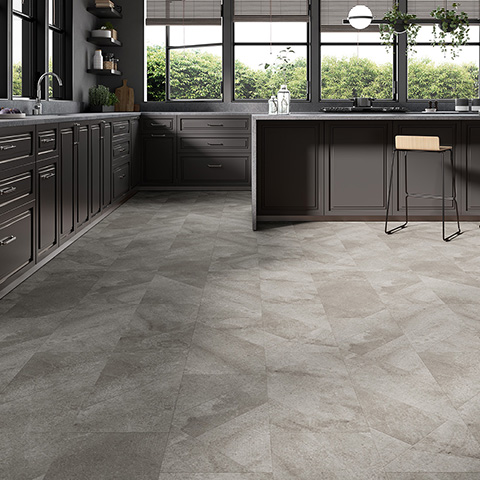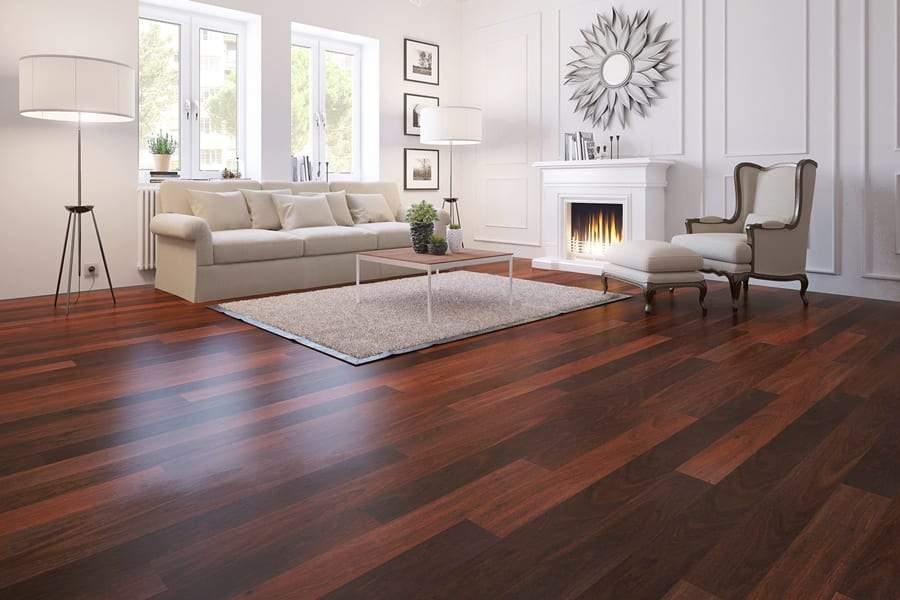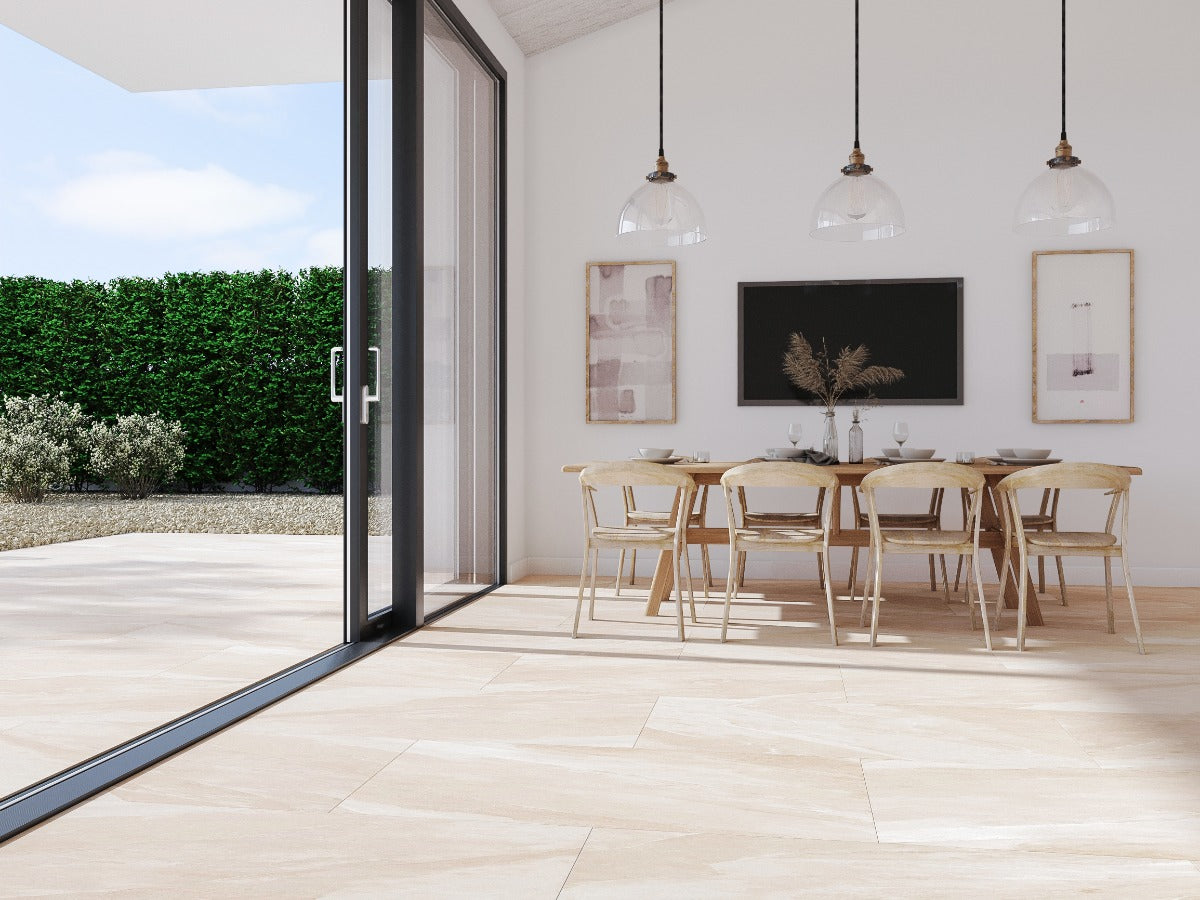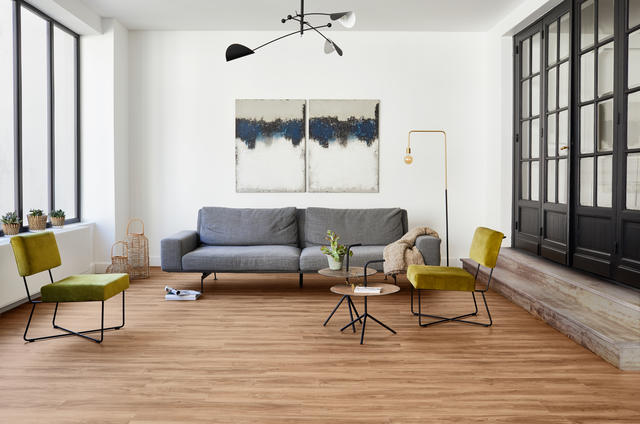
The 7 Vinyl Flooring Trends for 2025
Vinyl flooring keeps improving, giving homeowners stylish and strong choices. Here are the top vinyl flooring trends for 2025:
1. Wide Plank Vinyl Flooring
Wide planks make rooms look bigger and more luxurious with a seamless look. This style shows off the natural beauty of wood-look vinyl for a modern yet timeless feel.

2. Herringbone Patterns
Herringbone and chevron patterns are back, adding style and elegance to spaces. These patterns look great in both classic and modern interiors.

3. Chevron Patterns
Chevron vinyl has a bold, sleek look with an angular flow, perfect for 2025 trends.

4. Mixed Wood Tones and High Variation Designs
Mixed wood tones and high variation designs add depth and character to floors. This trend moves towards more natural and eclectic styles.
5. Stone-Look Vinyl (Slate, Marble, Travertine)
Vinyl that looks like stone such as slate, marble, and travertine combines elegance with comfort and affordability. These designs provide a luxury look for many rooms.

6. Matte Finishes and Low-Sheen Textures
Matte finishes and low-sheen textures are popular for hiding scratches and dust, offering a sleek look with less maintenance.

7. Natural Grain Embossing and Registered Finishes
New printing tech gives vinyl realistic textures that match the visual grain, called registered embossing. This makes wood-look vinyl appear very authentic.

8. Seamless Indoor-Outdoor Transitions with Vinyl Tile
Vinyl tiles that create a seamless look between indoor and outdoor spaces are trending, offering durability and weather resistance.

Vinyl Flooring Colors & Finishes Trending Now
In 2025, vinyl flooring colors are moving toward warm, natural tones with rich textures. These styles make rooms feel cozy and interesting.
🌾 Warm Greige and Honey Oak Tones
Greige vinyl, a mix of grey and beige, looks great with modern farmhouse and transitional styles. Honey oak brings a golden warmth to kitchens and living rooms, making them feel inviting.

🏖️ Coastal Whitewashed Planks
Light, beach-inspired tones are returning. These whitewashed vinyl planks make small rooms brighter and give a relaxed feel.

☕ Rich Espresso and Charcoal Tones
For bold interiors, dark shades like espresso and charcoal offer a sleek look and hide dirt in busy areas.

🪵 Distressed and Reclaimed Wood Looks
Vinyl with aged textures and saw-mark details looks like reclaimed barn wood, ideal for rustic or industrial styles, adding character without the hassle of real wood.

🎨 Subtle Pattern Layering for Depth
Many vinyl floors now have layered designs like soft wood graining and mineral veining, adding richness and movement without being too strong.

Best Vinyl Flooring Types by Room
Picking the right vinyl floor for each room makes sure it works well, lasts long, and looks nice.
Kitchens: Waterproof LVP with Slip Resistance
Kitchens are busy places where spills and moisture happen. Waterproof Luxury Vinyl Plank (LVP) with slip-resistant features is strong and safe. It looks like real wood or stone, making the kitchen look better and feel comfy.

Bathrooms: Sheet Vinyl or Rigid Core Vinyl Tiles
Bathrooms need flooring that handles lots of moisture. Sheet vinyl gives a smooth, water-resistant surface, and rigid core vinyl tiles are tough with many design choices.

Living Rooms: Textured Wood-Look LVP
In living rooms, textured wood-look LVP gives the warmth of wood and the strength of vinyl. It’s perfect where comfort and style matter.

Entryways & Mudrooms: Scratch-Resistant Vinyl Tile
Entryways and mudrooms have lots of foot traffic and dirt. Scratch-resistant vinyl tiles are strong and simple to clean, great for these spaces.

Rentals: Peel-and-Stick or Click-Lock Vinyl Planks
For rentals, peel-and-stick or click-lock vinyl planks are easy to install and remove. They are a budget-friendly option that still looks good.

Top Reasons to Choose Vinyl Flooring in 2025
Vinyl flooring is still popular in 2025. It’s great for homeowners who want modern looks, lasting quality, and a good price.
💧 1. Waterproof for Any Room
Vinyl flooring handles spills in the kitchen, bathroom moisture, and basement dampness. Most luxury vinyl plank (LVP) and sheet vinyl are fully waterproof, ideal for wet areas.
🎨 2. Stylish and Affordable
Vinyl looks like real wood, stone, or tile with great textures. You get the high-end look without the high cost or maintenance.
🛠️ 3. Easy to Install
With click-lock or peel-and-stick styles, vinyl floors are easy to install yourself. It’s perfect for a quick project or for renters who need easy changes.
🦶 4. Soft and Comfortable
Vinyl flooring is softer than tile or wood. It’s comfy for long hours of cooking or for kids playing. A padded underlayer adds extra warmth.
Vinyl Flooring Cost Breakdown (2025 Estimates)
Vinyl flooring is a cheap choice for nice, strong floors in 2025. Here are the prices for the most popular types:
💲 Vinyl Flooring Cost Per Square Foot (Materials Only)
| Type | Average Price (2025) | Key Benefits |
|---|---|---|
| Sheet Vinyl | $1 – $3 | Seamless, waterproof, soft underfoot |
| Luxury Vinyl Plank (LVP) | $2 – $5 | Wood-look visuals, waterproof, cushioned |
| Luxury Vinyl Tile (LVT) | $2 – $6 | Stone/tile looks, modular design, durable |
| Rigid Core Vinyl (SPC/WPC) | $3 – $7 | Enhanced stability, dent-resistant, waterproof |
| Peel-and-Stick Vinyl | $1 – $2.50 | Easy DIY, renter-friendly, low-cost fix |
| Click-Lock Vinyl Plank | $2 – $4.50 | DIY-friendly, floating floor, easy to replace |
🛠️ DIY vs. Pro Installation Costs
DIY Installation: Many vinyl types are made for homeowners, especially click-lock and peel-and-stick styles. You only need to buy underlayment and basic tools.
Professional Installation: Costs $2–$5 per sq ft, depending on material type, subfloor condition, and room complexity.
⏳ Longevity & Investment Value
Sheet Vinyl: 10–15 years (great for low-traffic or budget spaces)
LVP & Rigid Core: 15–25 years (ideal for kitchens, living areas, and moisture zones)
Peel-and-Stick: 5–10 years (perfect for rentals or short-term upgrades)
👉 Want to see a detailed pricing chart with pros and cons? Visit our full Vinyl Flooring Cost Guide
When to DIY vs. Hire a Pro for Vinyl Flooring Installation
Vinyl flooring is liked because many styles can be put in without needing a professional. But, depending on what you choose and your room’s design, hiring an expert might save time, stress, and avoid mistakes.
Here’s how to decide if you should do it yourself or call an expert:
🏠 DIY Installation: Best for Simple Spaces & Click Systems
If using click-lock vinyl planks or peel-and-stick tiles, and your room is mostly square without tricky cuts, DIY is a good choice. These products are made for easy setup — even for beginners — using basic tools.
You’ll save on labor costs and work at your own pace, great for small changes or budget updates.
🧑🔧 Hire a Pro: Best for Complex Layouts or Permanent Results
Think about hiring a flooring installer if:
You’re using glue-down vinyl or sheet vinyl (hard to align or cut)
Your room has angles, curves, or multiple areas
You need subfloor repair or leveling
You want a warranty-backed, guaranteed result
Pros have special tools for the best fit and finish, ensuring long-lasting results.
📊 DIY vs. Pro Installation Comparison
| Factor | DIY Installation | Professional Installation |
|---|---|---|
| Best For | Click-lock, peel-and-stick vinyl | Glue-down vinyl, sheet vinyl, complex layouts |
| Skill Level Required | Beginner to intermediate | None — handled by trained pros |
| Tools Needed | Utility knife, straightedge, mallet | Industrial cutters, rollers, glue tools |
| Prep Work | Homeowner must prep and clean subfloor | Installer handles subfloor leveling |
| Time Commitment | 1–2 days for most rooms | Usually completed in one day |
| Warranty Coverage | Often voided if not installed correctly | Manufacturer warranties typically valid |
| Average Install Cost | $0 (DIY) + tools (~$50–$100) | $2–$5 per square foot labor cost |
✅ Quick Tip
If your vinyl flooring needs glue or perfect alignment, and you want it perfect, it’s best to hire a pro.
👉 Need help with vinyl flooring installation? Check out our full How to Install Vinyl Flooring (DIY Guide) or Book a Free In-Home Consultation with our flooring experts.
Final Tips Before You Buy Vinyl Flooring
Before you buy, take a few steps to ensure your vinyl flooring looks good and lasts long.
📦 Buy Extra for Cuts & Waste
Purchase 10–15% more vinyl flooring than your room size. This helps with edge cuts, errors, and future repairs, especially for patterns like herringbone.
💡 Try Samples in Home Lighting
Vinyl looks different in store lighting compared to your home. Place samples on your floor and check them in natural and artificial light during the day to avoid surprises.
🛡️ Check Warranties & Wear Layer Specs
Look at the wear layer thickness (in mils) — 12 mil or more is best for busy areas. Ensure the warranty covers water damage, fading, and installation mistakes. Some require pro installation.
💰 Think About Lifetime Value, Not Just Cost
A cheap floor might look good but wear out fast. Spend more on rigid core LVP or top brands for 15–25 years of durability. It’s a long-term money saver.
Need Help Choosing or Installing Your Vinyl Flooring?
You’ve looked at the new vinyl flooring styles, materials, and costs. You’re closer to having beautiful, strong floors at home. If you want to avoid the hard work, our team can help.
We do it all — from checking the subfloor and planning the layout to the exact installation of luxury vinyl plank, sheet vinyl, vinyl flooring stairs, vinyl floor tiles, and more.
We’ll help you pick the right vinyl style and type for your room, budget, and lifestyle — whether it’s for a busy kitchen, bathroom, or rental.
Click here to contact us today and set up your free home consultation to see if we serve your area!






